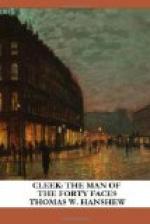“Right you are, Gov’nor.”
“Give me the sledge-hammer. Thanks! Now, Mr. Narkom, look!” And, swinging the hammer, he struck at the nymph with a force that shattered the monstrous thing to atoms; and Narkom, coming forward to look when Cleek bent over the ruin he had wrought, saw in the midst of the dust and rubbish the body of a dead man, fully clothed, and with the gap of a bullet-hole in the left temple.
Again Cleek’s hands began a rapid search, and again, as before, they brought to light a paper, a little crumpled ball of paper that had been thrust into the right-hand pocket of the dead man’s waistcoat, as though jammed there under the stress of strong excitement and the pressure of great haste. He smoothed it out and read it carefully, then passed it over to Mr. Narkom.
“There!” he said, “that’s how he lured him over to his death. That’s the message the pigeon brought. Would any man have failed to fly to face the author of a foul lie like that?”
“Beloved Mary,” the message ran, “come to me again to-night. How sweet of you to think of such a thing as the belt to get him over and to make him stop until morning! Steal out after he goes to bed, darling. I’ll leave the studio window unlocked, as usual. With a thousand kisses.
“Your own devoted,
“MAURICE.”
“The dog!” said Narkom fiercely. “And against a pure creature like Mary Morrison! Here, Smathers, Petrie, Hammond, take him away. Hanging’s too good for a beastly cur like that!”
* * * * *
“How did I know that the body was inside the statue?” said Cleek, answering Narkom’s query, as they drove back in the red limousine toward London and Clarges Street. “Well, as a matter of fact, I never did know for certain until he began to examine the thing to-night. From the first I felt sure he was at the bottom of the affair, that he had lured Carboys back to the house, and murdered him; but it puzzled me to think what could possibly have been done with the body. I felt pretty certain, however, when I saw that monstrous statue.”
“Yes, but why?”
“My dear Mr. Narkom, you ought not to ask that question. Did it not strike you as odd that a man who was torn with grief over the disappearance of a loved friend should think of modelling any sort of a statue on that very first day, much less such an inartistic one as that? Consider: the man has never been a first-class sculptor, it is true, but he knew the rudiments of his art, he had turned out some fairly presentable work; and that nymph was as abominably conceived and as abominably executed as if it had been the work of a raw beginner. Then there was another suspicious circumstance. Modelling clay is not exactly as cheap as dirt, Mr. Narkom. Why, then, should this man, who was confessedly as poor as the proverbial church mouse, plunge into the wild extravagance of buying half a ton of it—and at such a time? Those are the things that brought the suspicion into my mind; the certainty, however, had to be brought about beyond dispute before I could act.




